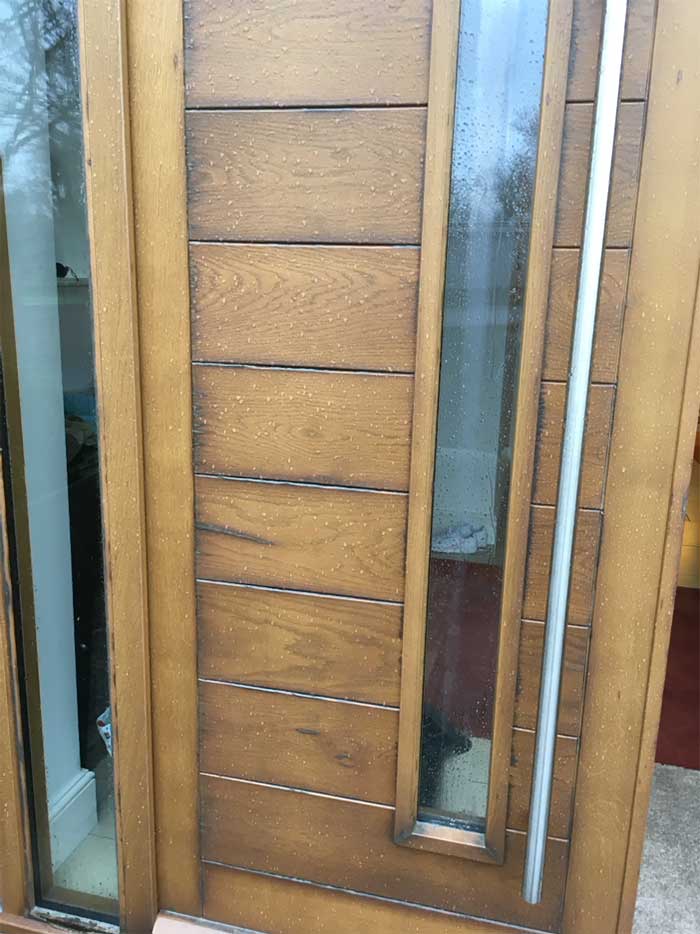RK ALUMINIUM DOORS NEWS
Which door material should I pick – Timber vs aluminium?
A lot of you come to us with the hard choice between timber or aluminium for entrance doors. On the surface both materials are great because they are versatile and can provide stunning results.
Many timber doors now effectively mimic aluminium with good paint finishes, and many aluminium doors can be designed with a wood grain or timber effect. There’s many different specifications and options out there which are fun to explore.
However, there are some important differences to consider before making a new door purchase:
Finish
Real wood grain is very hard to mimic but we have developed a range of foils, decors, and coatings which provide life-like ‘faux-timber’ doors. With that said, they don’t degrade like real timber; if ageing or silvering is important then timber should be considered. If you want a finish which is wipe clean, maintenance free and promises to look the same for decades then our doors are the right choice.
Aluminium doors have a wider variety of finishes available from powder-coating, metallic coating, precious metal coating, ceramic applications, and glass applications – there’s just more choices to pick from than timber alternatives.

Rustic Steel Elite Metal Coated RK450 Pivot Door

RK170 Wenge HD Aluminium Door
Insulation and weatherproofing
Timber doors have been popular for hundreds of years because timber is a good natural insulator. For many years, it was the best possible choice. However, since the introduction of U-PVC in the 80’s we started to look at timber like an old uncle still wearing his football t-shirt from the 1960s. When talking about thermal efficiency we talk about the ‘u-value’, and the simple rule for u-values is the lower the better.
Back in 2010, the rules and regulations for building work changed, bringing the maximum u-value for doors down to 1.8W, and the standard external wooden door would have a u-value of 2.5-3W. For a timber door to be high performing it usually requires tremendous effort and use of different materials and results are often less than mind blowing. This combined with the fact that many timber doors simply fail to be airtight after normal expansion and contraction means they aren’t the solution for the energy-savers amongst us!
If you’re looking for passiv-haus doors make sure to get a written guarantee that they will provide the result you need for air tightness testing. Doors which fail to provide an airtight seal also risk leaking rainwater. In otherwords, a worst-nightmare for the homeowner.
RK Doors can be specified with extra insulation and deep thermal breaks reach a u-value as low as 0.6W! An obvious benefit in this application as they are also airtight for this kind of testing.
Maintenance
This really comes down to how handy you are, and how much time you have on your hands. A lot of clients underestimate just how much work timber doors can be to preserve.
Here’s a real-world example:

Quality timber doors on the day of installation
However, they require serious attention just 12 months later:

Timber doors about a year after

Timber doors degrading
These doors really suffered from a multitude of issues:
Peeling paint
Cracked panels
Blown glass units
Leaking
Issues with opening, closing and locking.
Insecure fitment
Unfortunately, these timber exterior doors just aren’t maintenance free regardless of the certified treatment or finish. As you can see, they no longer do justice to a high-quality property.
To repair this the door the owner will have to go through 10 different steps:
1. Have handles and hardware external hardware.
2. Have doors removed to reach beads and threshold properly.
3. Be sanded thoroughly.
4. Replace blown glazing units due to leaking beads.
5. Be cleaned, and masked.
6. Be primed or lacquered (up to 3 coats required)
7. Be painted (finished with top coat – 3 coats required)
8. Reassemble the doors
9. Adjust door on hinges to ensure operation- possibly plane edges.
10. Repeat every 1 – 3 years.
The initial purchase of these doors was attractive because it was cheaper than alternatives, but the cost of this labour and materials, year on year has basically evened the playing field. In the end, the customer decided to replace the whole structure for aluminium because she didn’t want the stress or work.
Price is pain:
The final elephant in the room is price. Timber doors from a local joiner will always be much cheaper than a certified aluminium product. It is very simple really. Aluminium extrusion, powder coating, CNC and assembly is a much more lengthy and costly process to perform.
Hopefully, the points above will lead you to the correct investment for you. If cost is the ultimate factor, especially for a short-term solution, then timber could be the choice.
If you require a large statement door, want the best thermal performance, and hate the idea of maintenance then design a door on our website today. There is bound to be a door you will fall in love with and admire for years to come. Best of all, our finishes are backed up with a 10-year warranty against fading and ageing!
For those of you looking at cost savings the Eco and Entre’ ranges offer an affordable opportunity into high quality door ownership. These ranges are the same material construction; made entirely of aluminium with marine-grade powder coating so they will look as great as the day of install decades later.

RK1100 Entre in Black Wood HD
Contact us today, as we’d love to help you with a door design: info@rkdoorsystems.co.uk / 01872 222300
Written by Ben Johnson
Share this article by email or on Facebook
